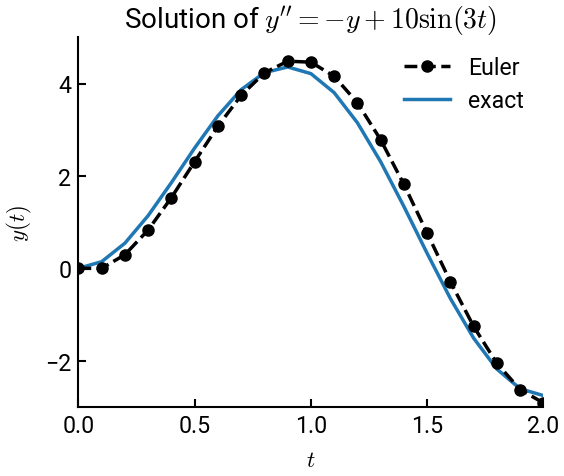Example 11-2: User-defined functions#
Note
Click the and open this notebook in Colab to enable interactivity.
Note
To save your progress, make a copy of this notebook in Colab File > Save a copy in Drive and you’ll find it in My Drive > Colab Notebooks.
We will provide another demonstration of Euler’s method, but this time, we’ll write a custom function for the first derivative. You will often have to write your own functions when programming and you’ll have many opportunities to practice doing so in this course.
Summary of commands#
In this exercise, we will demonstrate the following:
Writing our own function in Python.
Euler’s method with custom function#
Consider the following IVP:
The exact solution is \(y = -3 \cos (3t) + \sin (3t) + 3e^{-t}\).
We’ll numerically solve this ODE using a step size of \(h = 0.1\).
Writing your own function#
In Python, the syntax for defining your own function is:
def my_func_name(arg1, arg2, ...):
""" optional docstring to explain purpose, arguments, etc. """
do something
return something # optional
my_func_name(args) # calling the function
The
defat the start is required, as is the colon at the end of the first line.Just like variables, function names should be descriptive.
Arguments are optional, but you should have some input variables.
Docstrings are optional but very nice to have (for others and future you). No need though if the function is very simple.
Variables defined in the function body (including arguments) have local scope, i.e., they don’t exist outside the function.
Returning a value is generally optional, but you should have the functional expression here.
Once the ODE function is written, we can call it in the loop.
# import libraries
import numpy as np
import matplotlib.pyplot as plt
# user-defined function
def myODE(t, y):
return -y + 10 * np.sin(3 * t)
# initialize
h = 0.1
t0 = 0
tf = 2
y0 = 0
y = [y0]
t = np.arange(t0, tf+h, h)
# Euler for loop and exact solution
for n in range(len(t) - 1):
y.append(y[n] + h * myODE(t[n], y[n])) # this is where the function goes!
y_exact = -3 * np.cos(3 * t) + np.sin(3 * t) + 3 * np.exp(-t)
# plot and compare with exact
fig, ax = plt.subplots()
ax.plot(t, y, 'k--o', lw=2.5, label='Euler')
ax.plot(t, y_exact, lw=2.5, label='exact', zorder=-5)
ax.set(xlabel='$t$', ylabel='$y(t)$', title=r"Solution of $y'' = -y + 10 \sin(3t)$",
xlim=[0, tf], ylim=[-3, 5])
ax.legend()
plt.show()


